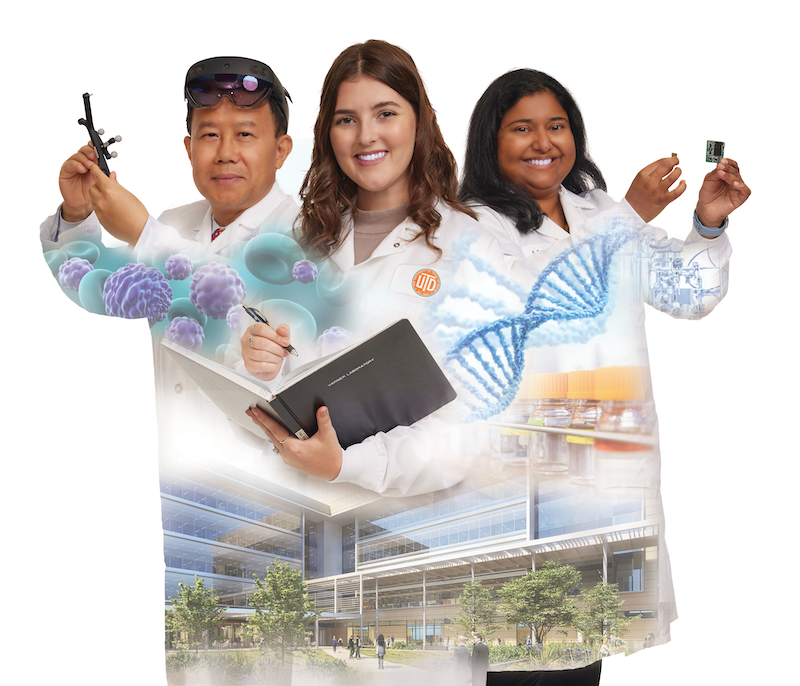 From left: Dr. Baowei Fei, Kara Peak and Dr. Shalini Prasad
From left: Dr. Baowei Fei, Kara Peak and Dr. Shalini PrasadUT Dallas bioengineers strive for health care solutions through innovation and entrepreneurship.
 From left: Dr. Baowei Fei, Kara Peak and Dr. Shalini Prasad
From left: Dr. Baowei Fei, Kara Peak and Dr. Shalini PrasadInside his glass-walled lab at The University of Texas at Dallas, Dr. Baowei Fei is working to develop a handheld cancer screening device that anyone could use at home to detect cancer at an early stage.
He already has developed technology that can accurately predict whether cells are cancerous – in real time and without radiation or contrast agents. The next step is to shrink his 200-pound prototype to fit into a small device as accessible as a cellphone.
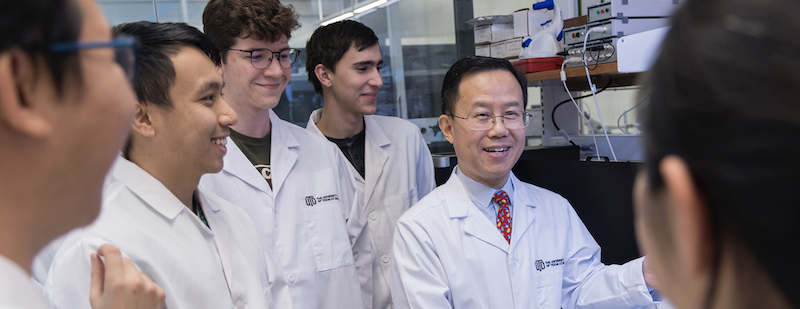
“I’m envisioning making it as small as a flashlight or pen. You can take a picture; send it to the cloud; then the physicians can take a look and give you advice,” said Fei, professor of bioengineering and the Cecil H. and Ida Green Chair in Systems Biology Science.
Fei’s smart, portable scanning technology, which uses a form of optical imaging– called hyperspectral imaging – combined with artificial intelligence, is just one example of how UT Dallas bioengineers are on the forefront of developing innovative ways to detect and treat diseases, improve and save lives, and reduce health care costs.
“Over the past decade, bioengineering at UTD has emerged as a force to reckon with. We have built a program that embodies diversity, research and entrepreneurial excellence that impacts the local DFW community and beyond.”
— Dr. Shalini Prasad
Engineering Better Health Care
From smart scanners to high-tech treatments involving gene therapy, synthetic tissue or nanoparticles, the solutions to many of health care’s greatest challenges increasingly rely on the expertise of bioengineers. The COVID-19 pandemic, for example, fueled a drive for novel vaccines, better diagnostic tools and effective treatments, while an aging U.S. population has generated demand for assistive medical devices.
Even without a medical school, UTD innovators have established a successful track record of improving patients’ lives. For example, researchers with the Texas Biomedical Device Center, supported by Texas Instruments (TI) and the UT System, conceived a therapy to rewire circuits in the brain through vagus nerve stimulation (VNS) more than a decade ago. In 2021 the Food and Drug Administration approved the rehabilitation system for chronic ischemic stroke survivors – the first such treatment of its kind. A biotech startup called CerSci Therapeutics was founded by a bioengineering alumnus and neuroscience researchers to develop non-opioid pain relief therapies; the company was sold to a pharmaceutical firm in 2020 for $52.5 million.
The University upped its stake in biomedical research in 2010 with the inception of the Department of Bioengineering in the Erik Jonsson School of Engineering and Computer Science. Over the last decade, as it focused not only on groundbreaking research but also on training the next generation of innovators, UT Dallas’ undergraduate biomedical engineering program grew to be one of the nation’s largest, with 600 students. UTD’s graduate program in biomedical engineering attracts students from around the world and ranks third among Texas public universities, according to U.S. News & World Report.
The program continues to expand its reach. A new partnership with UT Southwestern Medical Center – and a new joint research building scheduled to open this year – will serve as a catalyst for more partnerships between the institutions.
“Over the past decade, bioengineering at UTD has emerged as a force to reckon with. We have built a program that embodies diversity, research and entrepreneurial excellence that impacts the local DFW community and beyond,” said Dr. Shalini Prasad, department head of bioengineering. “We are now poised to build out our translation portfolio and have a long and sustained impact to human health and well-being with our collaboration with UT Southwestern.”
Diverse Department, Broad Interests
Prasad, who is also a Cecil H. and Ida Green Professor in Systems Biology Science, leads by example. Her work illustrates how UTD bioengineers are pushing the boundaries of health care. She and her research team have developed a technology platform for several types of biosensors, including wearable devices that can monitor a person’s health based on molecules in their sweat.
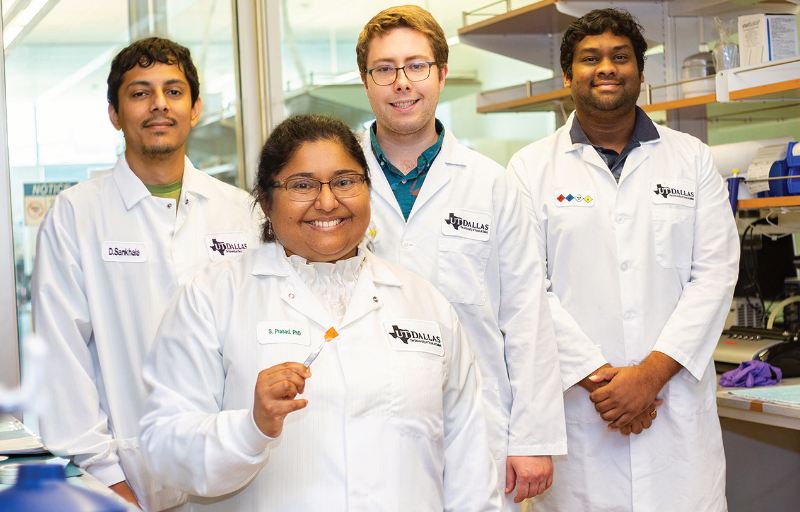
“The wearable sensor is like having a check-engine light,” Prasad said.
Prasad’s group has shown that their sensors can detect infections such as COVID-19, influenza and sepsis, plus inflammatory bowel disease. She collaborates with industry – including EnLiSense, an Allen, Texas-based company she co-founded – to commercialize her discoveries.
In 2022 Prasad became the sixth faculty member and the first woman at UTD to be elected as a fellow of the American Institute for Medical and Biological Engineering in recognition of her work on the sepsis sensor.
Prasad also has trained exceptional graduate students who have found success in academia and industry, among them Ambalika Tanak MS’16, PhD’21 and Badrinath Jagannath PhD’21, who each received the prestigious Baxter Young Investigator Award, which supports research to develop therapies and medical products that save and sustain patients’ lives. Tanak now works at Baxter International Inc., and Jagannath is a research fellow at the Wyss Institute at Harvard University.
UTD bioengineering faculty and researchers lead a broad range of projects supported by the National Institutes of Health (NIH), the National Science Foundation, and the Cancer Prevention and Research Institute of Texas, among other funding sources.
One of those projects involves an implantable device that electrically stimulates neurons to produce a form of visual perception to help people with blindness better recognize objects and navigate their surroundings. Working with researchers at the Illinois Institute of Technology, Dr. Stuart Cogan, professor of bioengineering, designed the electrode array that is placed into the cortex of the brain. Electrical current passes from the metal electrodes to the brain to produce visual perceptions. So far, one patient has received the implant.
“The participant is reporting a variety of electrical stimulation-induced perceptions,” Cogan said.
Another area of research in the department involves finding more effective ways to deliver medications directly where they are needed in the body.
Dr. Shashank Sirsi, associate professor of bioengineering, has developed a method to send medication to a target using microbubbles – tiny, sound-sensitive, gas-filled spheres that burst when exposed to ultrasound. The implosion temporarily widens gaps in blood-vessel walls and releases drug-carrying nanoparticles at the precise location of a tumor while researchers guide and monitor the process with ultrasound imaging. Sirsi’s group is also using this technology to deliver genetic material that sensitizes tumors to chemotherapy and radiotherapy, reducing treatment to very low dosages.
“We are located near one of the best neuroblastoma treatment centers [UT Southwestern and Children’s Health] in the country,” Sirsi said. “Being able to meet with experts in pediatric cancers on a routine basis has been tremendously beneficial for developing my research program here at UT Dallas.”
Crosstown Collaboration
The University’s proximity to UT Southwestern is a significant factor in the bioengineering program’s success. Bioengineering faculty members, along with researchers in other disciplines, collaborate routinely with clinicians and scientists at the academic medical center, which gives researchers access to patient samples, data and specialized facilities.
UTD bioengineers currently are working with UT Southwestern researchers on 14 different projects funded by nearly $7 million in research grants. Nearly one-third of bioengineering faculty members have labs at UT Southwestern, and in the 2021-22 academic year, five bioengineering doctoral students and more than 20 undergraduate students conducted research in UT Southwestern faculty members’ labs. UT Southwestern faculty also sponsored 15 student-led UTDesign projects in the last academic year, including a device for recycling 3D-printed material that placed second in the American Society of Mechanical Engineers Student Design Competition.
Several faculty members, including Fei, also hold joint faculty appointments at UT Southwestern, where he is a professor of radiology.
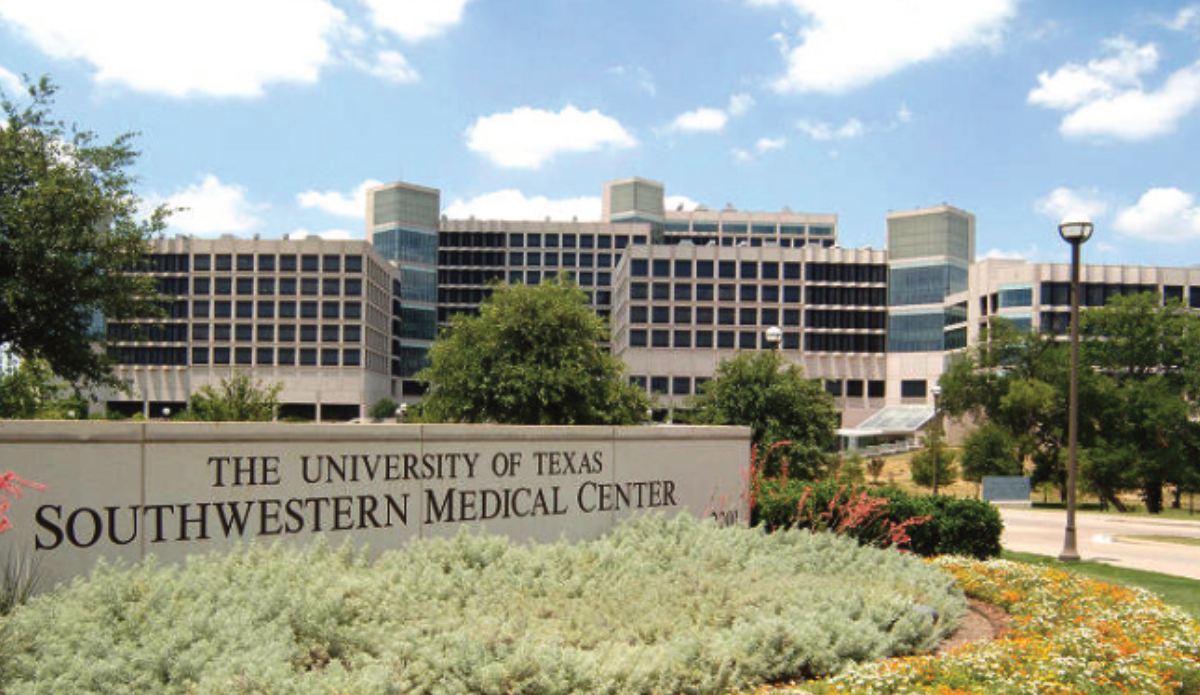
“Collaboration with UT Southwestern has been a huge benefit,” Fei said. “At UTD, we have the strength of being a young university, and we’re dynamic. We’re developing cutting-edge technologies. We have a lot of engineers, and we have very smart students. Those are all factors that help develop new technologies on the frontier.
“UT Southwestern has many clinicians and clinical research areas. Their physicians are eager to work with us because any kind of technological innovation will bring benefit to human health and improve patient care.”
The close interaction between UTD bioengineers and doctors, nurses and patients can lead to new ideas and further innovation, said Dr. Joseph Pancrazio, the University’s vice president for research and innovation and a professor of bioengineering.
“Exposure to those environments can mean everything for a graduate program in biomedical engineering or other sciences,” Pancrazio said.
When Dr. Matthew Petroll, professor of ophthalmology and chair of the biomedical engineering graduate program at UT Southwestern, needed help with his research into the eye’s self-healing process, he approached Dr. David Schmidtke, UTD professor of bioengineering.
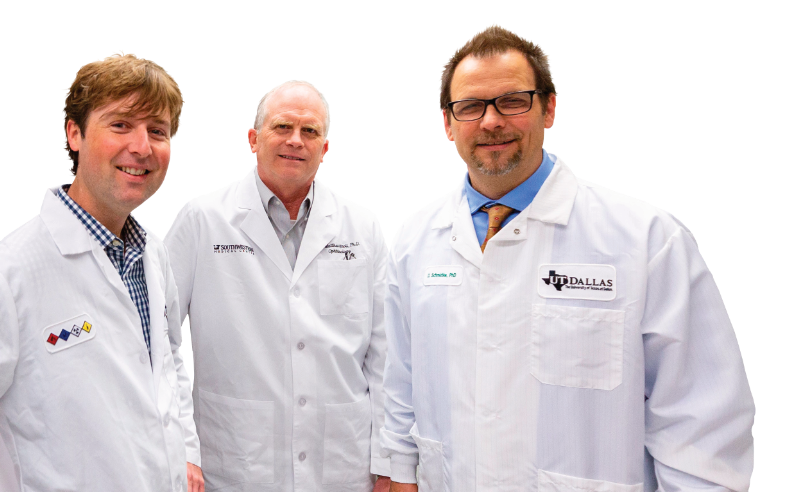
Schmidtke is an expert in microfluidic devices, which are palm-sized pieces of transparent plastic that contain small channels about the size of a strand of human hair. He is using the devices to fabricate collagen fibrils present in corneal tissue. Supported by a $1.8 million grant from the National Eye Institute of the NIH, UTD bioengineering graduate students from Schmidtke’s and assistant professor of bioengineering Dr. Victor Varner’s groups are collaborating with researchers on Petroll’s team to investigate how the density, elasticity and dimensionality of the fibrils affect keratocyte behavior during wound healing.
“The partnership with UT Southwestern, and having research lab space there, has been a big benefit to applying engineering tools to biomedical questions,” Schmidtke said.
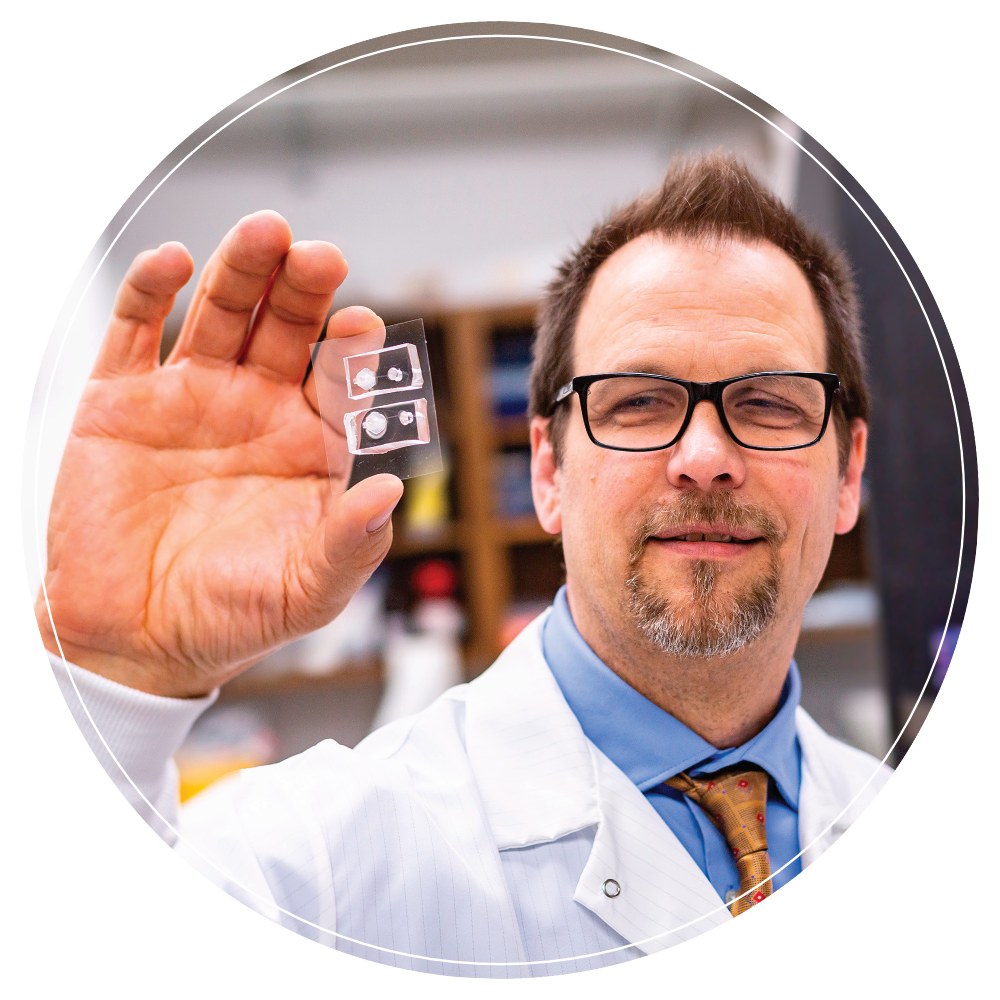
In other collaborations, Dr. Danieli Rodrigues, associate professor of bioengineering, began working with Dr. Javier La Fontaine when he was a professor of plastic surgery at UT Southwestern and fellowship director of Limb Preservation at Parkland Health & Hospital System. He was appointed the inaugural dean of the UT Rio Grande Valley School of Podiatric Medicine in June 2022. The two researchers are working together to develop new immunomodulatory coatings for metallic orthopedic and dental implants to target healing and the integration of bone into the implants in diabetic patients.
Dr. Yichen Ding, assistant professor of bioengineering, has partnered with Dr. Eric Olson, chairman of molecular biology at UT Southwestern, to use laser sheets for cardiac imaging.
Ding serves on the faculty of UT Southwestern’s Hamon Center for Regenerative Science and Medicine, which is led by Olson. Center researchers focus on understanding the fundamental mechanisms of tissue formation and repair and use that knowledge to develop transformative strategies and medicines to enhance tissue regeneration. Olson and his trainees discovered many of the genes that control heart and muscle development and disease, and the stress-response pathways that underlie pathological cardiac remodeling. Olson also co-directs UT Southwestern’s Senator Paul D. Wellstone Muscular Dystrophy Cooperative Research Center, one of six such NIH centers in the U.S. A member of the National Academy of Sciences, Olson has co-founded multiple biotechnology companies.
At UTD, Dr. Heather Hayenga, associate professor of bioengineering, and Dr. Leonidas Bleris, professor of bioengineering and a Cecil H. and Ida Green Professor in Systems Biology Science, are working with Dr. Helena Hwang, associate professor of pathology at UT Southwestern, to develop a gene-editing treatment for solitary fibrous tumor (SFT), which is caused by two genes fusing on one chromosome. The disorder causes normal genes to turn into oncogenes that have the potential to transform a healthy cell into a cancerous cell at any time.
Hayenga has a personal connection to this work. She was diagnosed with SFT in 2014 and began studying the disease with the help of Bleris, who is a genetic engineer. In the past few years, her cancer has progressed, but she remains focused on continuing her efforts to increase knowledge of the disease and develop effective treatments. She said several cancers and genetic disorders are caused by specific gene alterations.
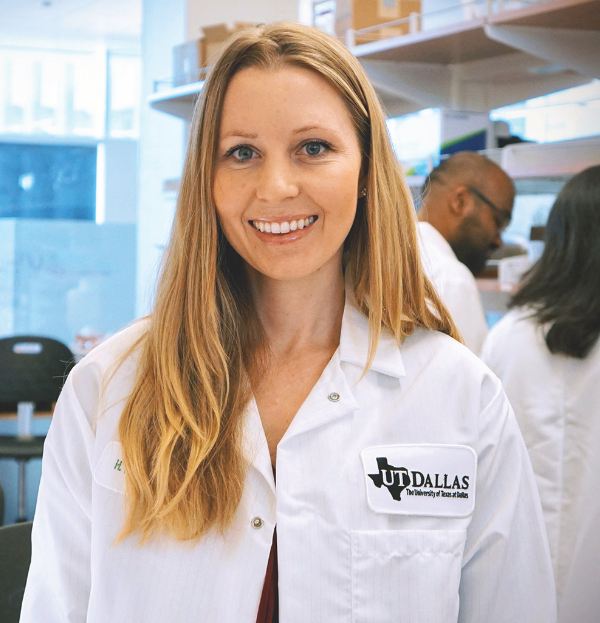
“One out of three people will get a cancer diagnosis in their lifetime,” she said. “With the help of our clinical and industry partners, we have developed promising therapies targeting SFT-specific gene alterations. In a matter of months, we hope to start treating SFT patients. We hope our gene-targeting therapy is only the beginning of a broader therapeutic approach.”
Joint projects between the two institutions have paved the way for biotech startups as well, like Glaucomedi. UT Dallas students working with Dr. Karanjit Kooner, associate professor of ophthalmology at UT Southwestern, won first place in the Student Pitch Track at the Institute for Innovation and Entrepreneurship’s Big Idea Competition at UTD in November 2021. The students developed a drainage device to treat glaucoma by reducing eye pressure.
The opportunity to work with UT Southwestern faculty was an important factor in UTD biomedical engineering doctoral candidate Kara Peak’s decision to enroll in the University. Students can earn graduate degrees from either institution as part of a joint enrollment agreement.
“When I started looking for graduate schools, I was immediately drawn to UT Dallas. Not only would I get a chance to move back closer to home near family, but the connection between UT Southwestern and UT Dallas helped seal the deal,” said Peak, who works on understanding the mechanobiology that directs lung airway development with Varner, who has a joint appointment in UT Southwestern’s Hamon Center.
Building Big Ideas
One of the newest collaborative efforts between the two institutions is the $120 million Texas Instruments Biomedical Engineering and Sciences Building, under construction on the UT Southwestern East Campus. The building, expected to open in 2023, is supported by a $15 million gift from Texas Instruments, $90 million from the Permanent University Fund of the UT System and additional philanthropic donations.
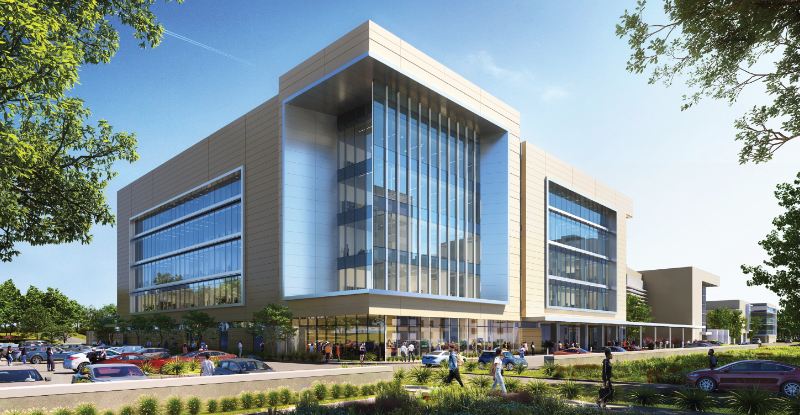
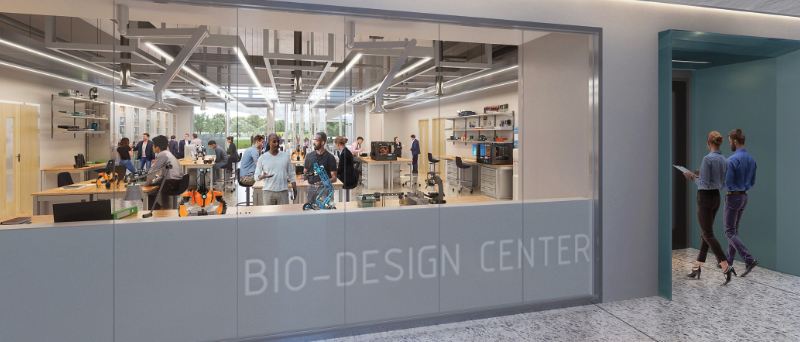
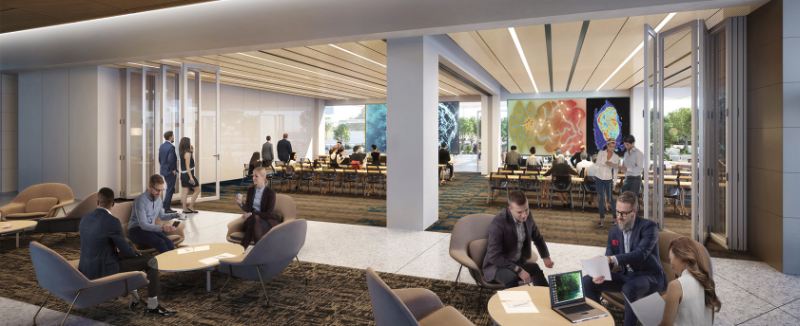
“The building is a physical representation of a partnership that expands beyond engineering,” Pancrazio said.
The five-story, 150,000-square-foot facility features wet and dry laboratory space, a Biodesign Center, a metal fabrication shop and labs for 3D printing. Some of the features and physical layout are inspired by UT Dallas’ Bioengineering and Sciences Building, which opened in 2016.
“We used the successful lessons we learned on our own campus to inform the design considerations for the new building,” Pancrazio said. “One of those is the idea of grouping investigators with aligned interests near one another. It promotes collaboration and interactions with students and builds communities where the students come up with the next big ideas.”
The building is versatile to adapt to changing needs, with mobile furniture and lab spaces, Pancrazio said. Officials envision fewer walls, with more of the type of open labs featured in UTD’s research facilities.
Dr. Stephanie G. Adams, dean of the Jonsson School and the Lars Magnus Ericsson Chair at UTD, said the new building will transform North Texas into a premier hub for biomedical innovation and education.
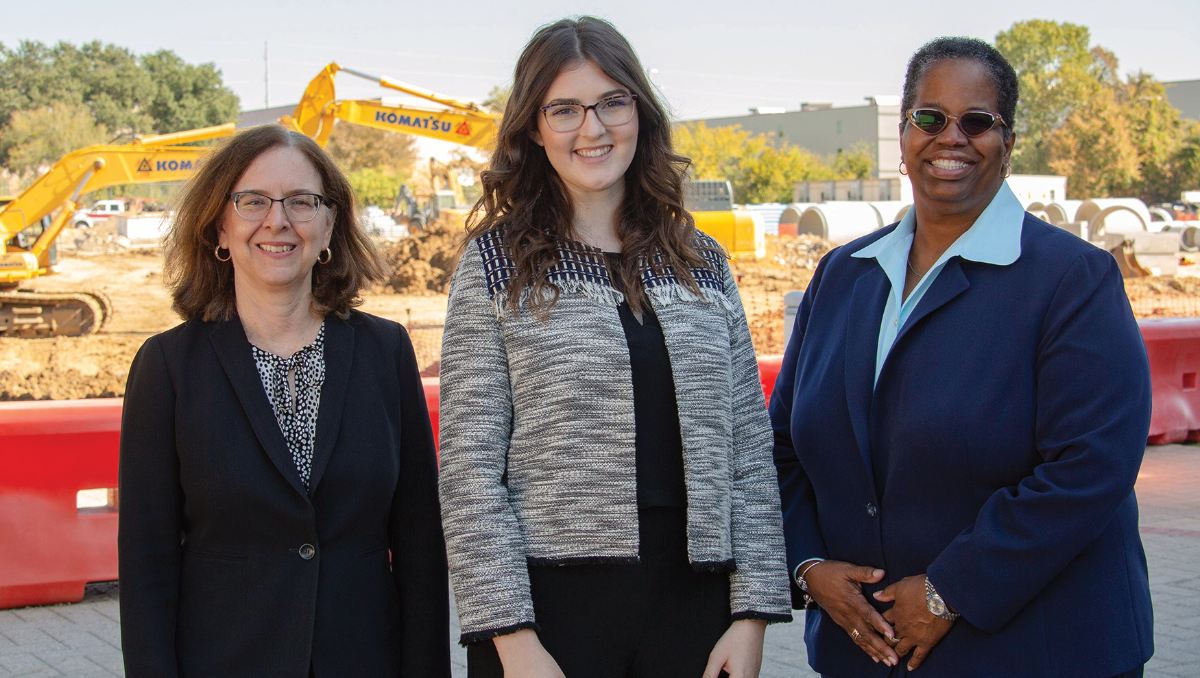
“This building solidifies the bridge that we’ve already built between biomedical sciences at UT Southwestern and bioengineering at UTD,” Adams said. “It is our hope that this multidisciplinary partnership will lead our colleagues and students on both campuses, as well as local industry giants, to the production of real-world applications to further enhance the quality of life and improve the human condition.”
Dr. Samuel Achilefu, chairman of UT Southwestern’s new Department of Biomedical Engineering, said the building will facilitate the kind of team engineering that made a COVID-19 vaccine possible in one year.
“When we can work together as a team, I believe we can transform the world as we know it today. The new building will help us accomplish that,” Achilefu said at a November 2021 groundbreaking ceremony for the building.
Innovation + Entrepreneurship
Just a few miles from UT Dallas, Fei is extending the University’s impact at the Center for Imaging and Surgical Innovation.
Fei’s center is one of several new UTD research centers at the Richardson Innovation Quarter, also known as the Richardson IQ. The 1,200-acre hub for innovation and entrepreneurship opened in fall 2022. The Center for Imaging and Surgical Innovation focuses on translating UTD research into products that can save lives by helping doctors get a better view of cancer cells and other diseases.
Fei’s noninvasive, radiation-free technology analyzes how cells reflect and absorb light across a broad range of the electromagnetic spectrum that includes ultraviolet and near-infrared light, going far beyond what the human eye and traditional tools can see.
“With imaging we are trying to push toward earlier detection, which is key to saving lives,” Fei said. “Once cancer becomes an advanced disease and starts to spread, survival is very low. We can save lives through early detection, and we can save on costs.”
It could take several years for Fei to bring his vision for a handheld cancer scanning device to fruition. The technology will need to be refined, tested, and made smaller and more cost-effective. But Fei is passionate about the potential of his and others’ research to create opportunities to meet the high demands of health care.
“The challenge is how to reduce the costs and make health care available to more people within our country and globally,” Fei said. “For myself, as an engineer, my role is to develop technology to make that happen.”



